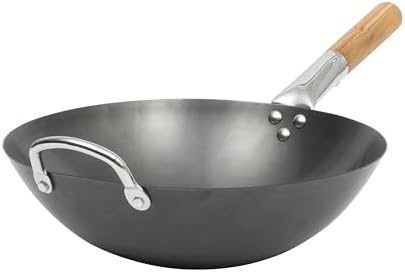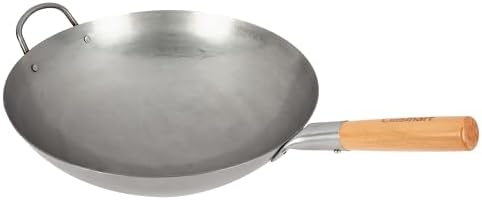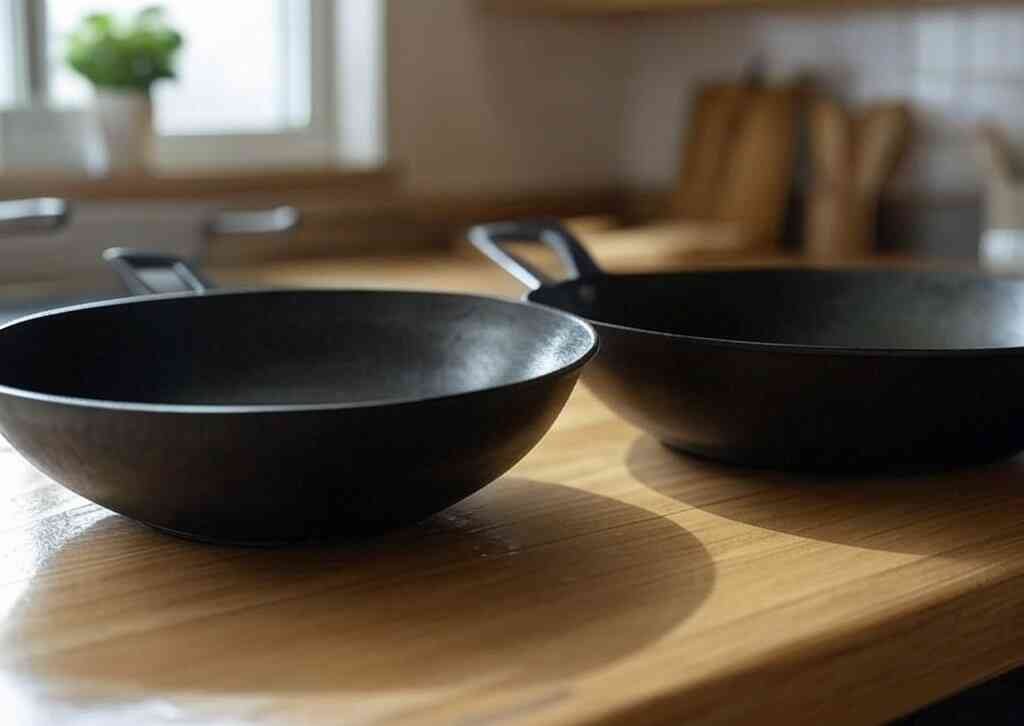Understanding Carbon Steel Woks
Carbon steel woks are common in every kitchen in the world, especially for high-heat cooking like stir-frying. Iron and carbon make up these durable woks known for their excellent heat conductivity. Carbon steel differs from non-stick or stainless steel because it blissfully combines a lightweight build with strong performance. It is ideal for fast cooking with high heat.
One of the big positives about a carbon steel wok is that it heats up very rapidly. It also retains heat evenly across the cooking surface. The reason even heat retention is beneficial in high-heat cooking is that ingredients need to sear immediately in order to lock in flavor. Another positive about carbon steel woks is that they develop a natural non-stick surface over time.
This is done by seasoning, where oil is applied to the wok and it is heated. This creates a polymerized layer. It widens the cooking area and enables the wok to be made durable. Carbon steel is less heavy than cast iron. It is therefore easy to handle when intensive cooking is being done. Also, it is able to withstand intense heat without distorting. This allows for better performance when cooking. Nevertheless, it is essential to season the wok prior. Unseasoned carbon steel will result in acidic foods reacting. This produces unwanted flavors.
To preserve the performance and longevity of a carbon steel wok, it needs good care. After each use, do not apply abrasive cleaners or strong detergents. These will strip off the seasoned coating. Instead, simply rinse it off with hot water and dry it thoroughly to prevent rusting. Having understood how carbon steel woks are produced and how effective they are, domestic cooks are now able to use this versatile cooking utensil confidently for high-heat cooking.
Basic Precautions When Cooking at High Heat
When a carbon steel wok is used to cook at high heat, safety comes first. This prevents accidents and results in successful cooking. One of the big safety precautions is using a cooking oil with a high smoke point. Examples include avocado oil, grapeseed oil, or refined peanut oil. Low smoke point oils can create unwanted smoke. Not only does this affect flavor in foods, but it can have breathing effects as well.
Wearing heat-resistant gloves is also a crucial safety measure. A carbon steel wok, which is designed to be cooked at high heat, may become scorchingly hot when cooking. This increases the risk of burns. You need to use heat-resistant gloves when handling the wok. This is most necessary while adding ingredients or removing it from heat. This minor safety precaution can be very effective in avoiding kitchen accidents.
Ventilation during high-heat cooking cannot be overlooked. Adequate kitchen ventilation helps distribute smoke and fumes. They can accumulate quickly. Opening a window, using exhaust fans, or having a portable fan improve ventilation substantially. This added ventilation eliminates the risk of smoke inhalation and yields a healthier cook.
Also, caution while cooking is vital. High-heat cooking requires close observation to avoid flare-ups. These may ignite fires. It’s best to avoid leaving the cooking process unsupervised. Be ready to deal with any accidents that arise immediately. Close monitoring of the cooking process ensures timely intervention. This involves adjusting heat or responding to any unforeseen events.
To provide a safe cooking environment, make sure that the cook and anyone in the vicinity are safe. Following these precautions when cooking with a carbon steel wok at high heat encourages a secure and enjoyable cooking process.
Best Practices for High-Heat Cooking Techniques
You can easily carry out high-heat cooking techniques like stir-frying, searing, and deep-frying with a carbon steel wok. The wok is particularly famous for its ability to carry out high-heat cooking. To maximize its capability, acquire critical practices that promote safety and culinary results.
Pre all ingredients prior to cooking. This includes chopping the vegetables evenly and marinating or seasoning the proteins. Preparation is key because rapid high-heat cooking. Having prep done goes a long way in avoiding burning or overcooking.
The correct temperature to cook with is crucial. For searing and stir-frying, heat the wok to a slight smoke. That indicates it is hot enough. To avoid the food sticking, always use high smoke point oils like canola or grapeseed. They help create a non-sticking surface. Also, never overcrowd the wok. This will drop the temperature and hinder correct technique of cooking.
Since you are employing deep-frying methods, ensure the oil is adequately heated. 350°F to 375°F temperature is apt for most foods deep-fried. A thermometer is recommended to be employed for best results. The temperature should be kept steady throughout cooking. This yields a golden crust on the outside and a soft inside.
Finally, and above all, the proper utensils are crucial. Wooden or silicon spatulas are ideal. They will not scratch the carbon steel surface. Maintaining the wok in good condition, for instance, seasoning after every use, will have it retain good heat conductivity and non-stick properties over time.
These recommendations maximize the effectiveness and safety of high-heat cooking in a carbon steel wok. This renders it an indispensable item in the kitchen.
Care and Cleaning Your Carbon Steel Wok for Safety
Clean and maintain your carbon steel wok well.
This not only provides it with a long lifespan but also with safe cooking. Clean your wok well after each usage to prevent food buildup and subsequent rusting. The best method of washing your carbon steel wok is by hand in hot water with a sponge or soft cloth. Never use tough detergents or abrasive scrubbers. They can remove the seasoning and defeat its non-stick properties. Dry your wok after washing to prevent moisture accumulation. Moisture causes rust. Dry it with a towel. Then heat it on low for about a minute or two. This dehydrates any remaining moisture. This dries the wok but also maintains the seasoning integrity of iron.
Its performance in cooking relies heavily on seasoning a carbon steel wok.
In order to maintain the non-stick surface integrity, you must reseason your wok periodically. Do it especially when food begins to stick or the surface feels dull. To reseason, apply a thin layer of high-smoke point oil—such as flaxseed or canola oil—onto the surface. Next, heat the wok until the oil begins to smoke. Do this repeatedly a couple of times in order to build up a protective layer. This enhances the wok’s cooking performance as well as safety. Storage-wise, it’s best to store your carbon steel wok in a dry area. You can place a paper towel or dish towel between your wok and cover, or between other pots and pans. This will absorb moisture and prevent any undesirable smell from entering. These are not only the best practices to maintain your wok in the best conditions but also contribute significantly to safe high-heat cooking in the long term.












[…] Cooking with a wok is most easily done with a thin sauce or broth that covers the round bottom of the wok and has a mouthfeel balanced by some density (think of the balance of density of flavor available with tofu as a choice for cooking). The advantage to a toroidal shaped wok is the exterior surface area of the wok heat on both sides when submering or steeping, not to mention use for cooking and stir frying vegetables. […]